Miss. Delicious #80 : The Cow Inn - Ximen, Taipei!
Dear Steemit friends:
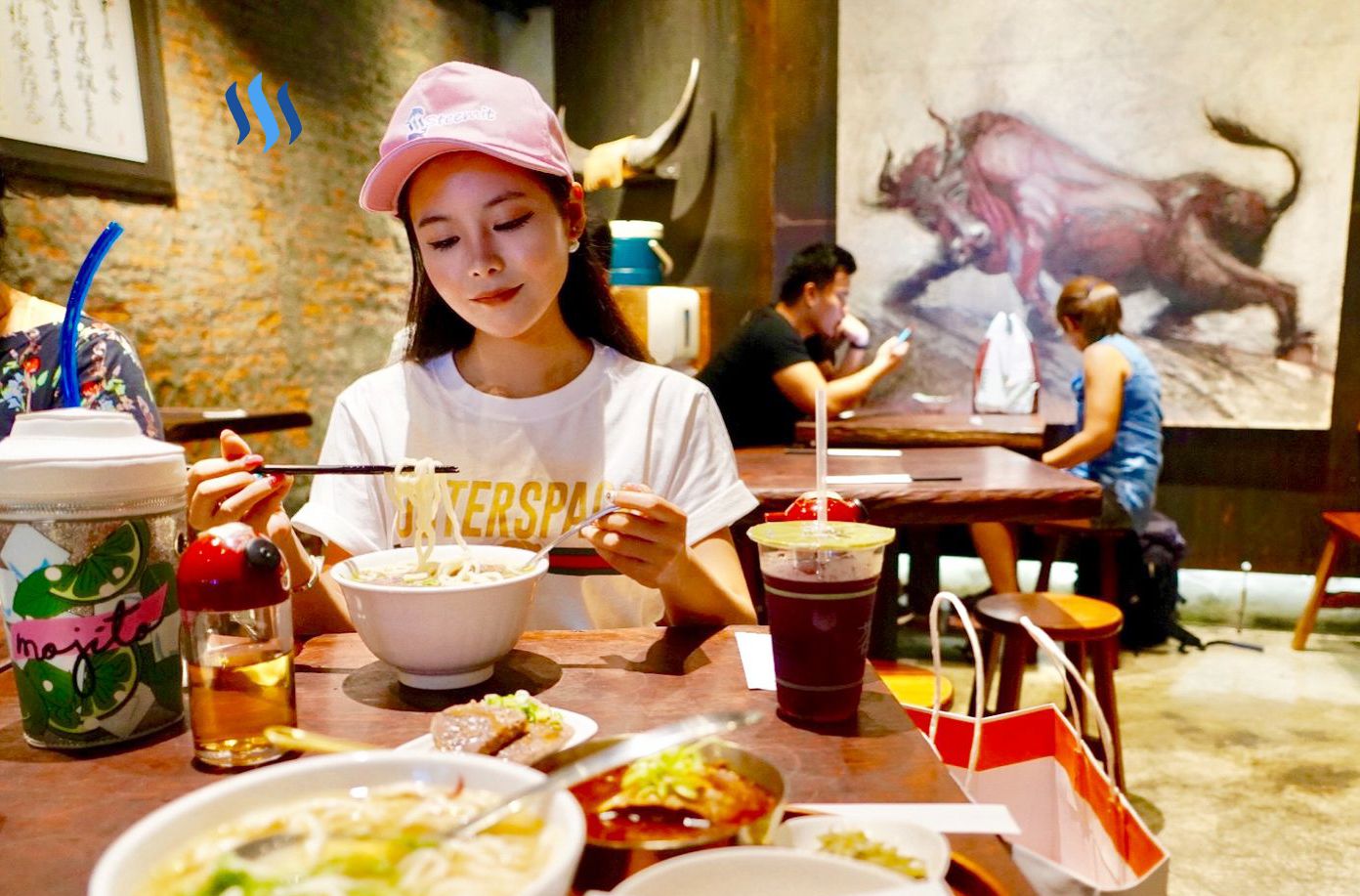

Today, Miss. Delicious is on a journey to find the taste of happiness. There's a saying in Chinese that delicious food brings joy and happiness. No doubt, Taiwan offers some of the most palatable food in all of Asia, and does so, so effortlessly devoid of gift wrapping, or assertive marketing. This is a place to taste food because it is in the rawest sense of the word, simply delicious.
Taiwan is home to a very ethnically diverse population having been occupied and visited by not only the mainland Chinese, but also the Japanese, Dutch, Spaniards, and even many Southeast Asians.
Because of Taiwan's early rise to development, it is known as one of the four Asian dragons which also include Singapore, Hong Kong and South-Korea. With this early affluent economy, Taiwan was able to assimilate delicacies from all over the world, blending them with it's own ethnically diverse traditions. The result - a nation labelled as the food heaven of the east.
Today, we'll be eating around the lively neighbourhood that is Ximending. This is one of the oldest neighbourhoods in Taipei, but remains one of the most lively. You are never too far away from alluring food waiting to be eaten, whether it's the snack foods, night market stalls, or full blown restaurants, the options are everywhere and you just don't have enough time (or stomach space) to try them all!
Just below where I lived, there is a beef joint, called Beef Shop. It's considered a five star beef noodle joint and has won awards of being a top 10 Beef Noodle Soup joint in Taipei at the 2010 Taipei International Beef Festival.
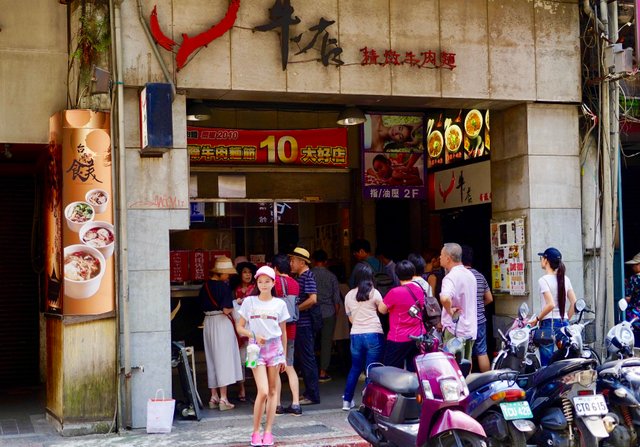
The restaurant is so popular that after passing and forth for several days, I never found the opportunity to just walk straight in to eat. There was always a queue. On this particular day, I decided that I would permit the waiting time and join the queue. It's as simple as writing your name down on the list then waiting to be called. All in all, about 30 minutes waiting time can be expected.
Outside, they have a few examples of their signature beef noodle soup dishes, as well as some of the cold appetisers frequently consumed with the noodle soup.
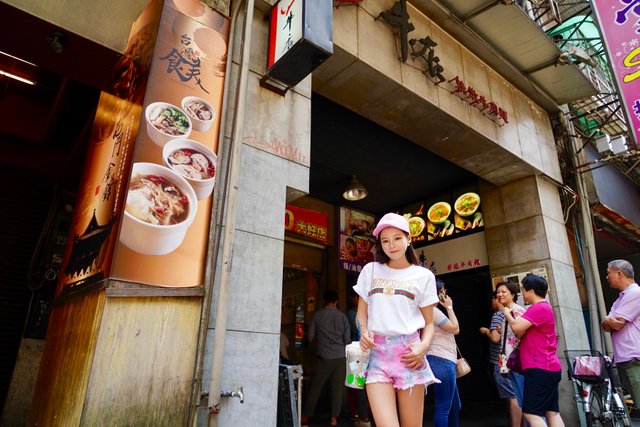
Like most shops, restaurants or stores in this area of town. They are tucked away inside the pavement which itself is overlapped by the buildings. It's a curious design, one which suggests that it probably rains a lot and people want the ability to walk around places without getting wet. In either case, the result is we have a lot of these places out of view, and a lot of neon lights and sign boards hanging on the side of buildings to advertise their existence.
These are all the people waiting, within the crowd, i hear a mixture of languages, there is of course English, but also Japanese. Clearly this place is more than just the talk of town, but probably also TripAdvisor (no, I haven't checked).
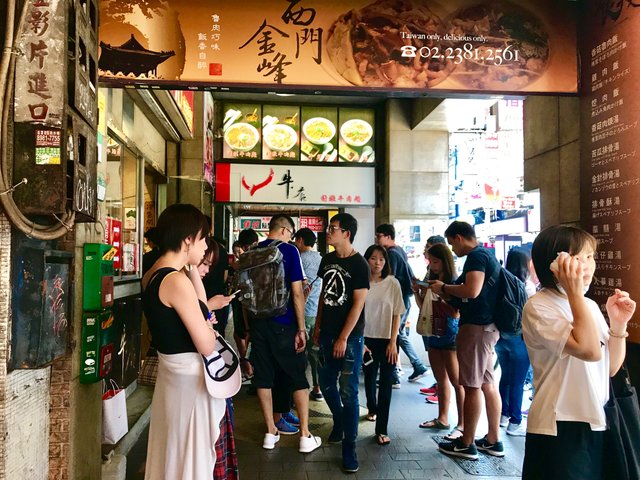
This is the sign stating that they're a top 10 Beef Noodle Soup restaurant in Taipei according to the 2010, Taipei Beef Festival. Knowing how essential Beef Noodle Soup is in Taiwanese Cuisine, that's quite a prestigious prize!
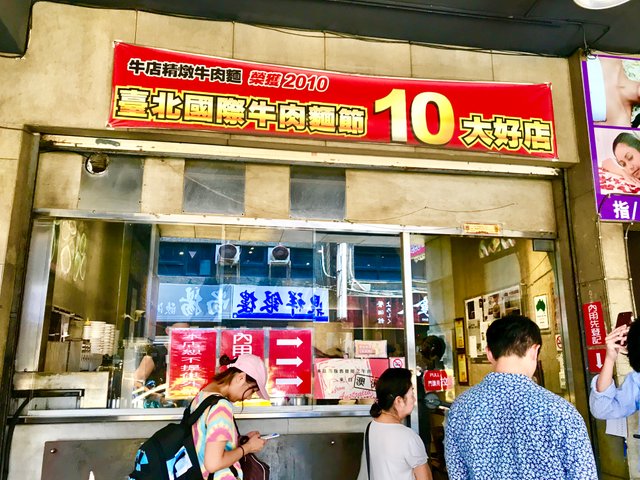
The restaurant is arranged such that the kitchen where they prepare the noodles, broth and beef is at the front by the entrance. Like in Hong Kong, you can see the chefs working tirelessly as they prepare the various dishes. The teasing aroma that seeps outside is a reminder to the people queuing, it's worth the wait.
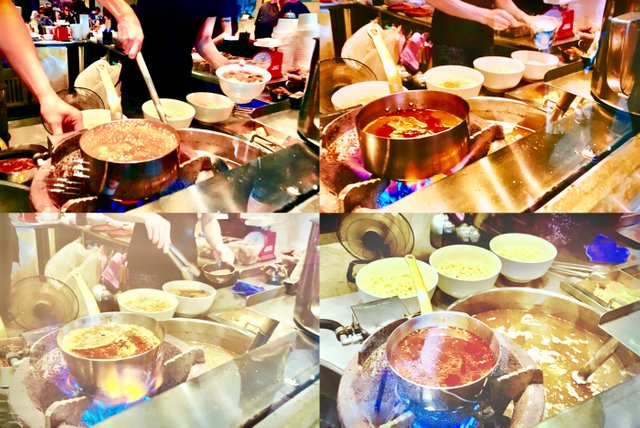
This is the menu of appetisers which you are given whilst waiting outside. Obviously, I was mistaken for being Korean because all the writing is in Korean !
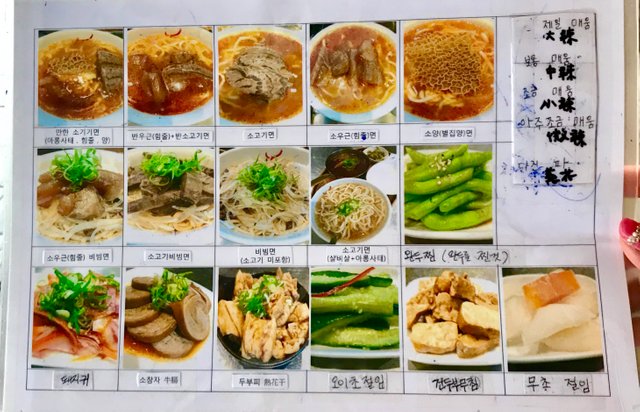
This is the Beef Noodle Soup menu, and also where you tick off which dishes you would like to order. As soon as you enter, this is handed to the kitchen, and they prepare your food right away. The red sign is pointing the "registration". This is where you write your name down to join the queue.
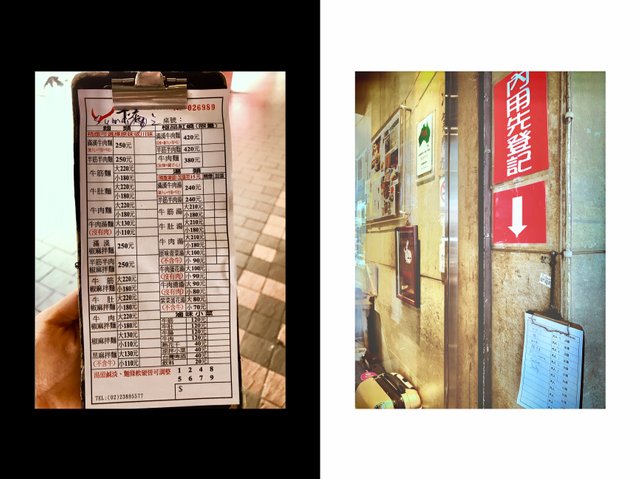
Once inside, you realise the restaurant is not very large at all. The kitchen already occupies nearly a third of the available space.
The cold dishes are pre-prepared and are at the end of the kitchen near the dining tables. Some restaurants even allow customers to serve themselves. Here, they are paid for at extra cost.
At first, I thought this board was decoration. The writing looked very much like Chinese poetry or calligraphy. At closer inspection, it is actually their menu! This is an example of functional decoration!
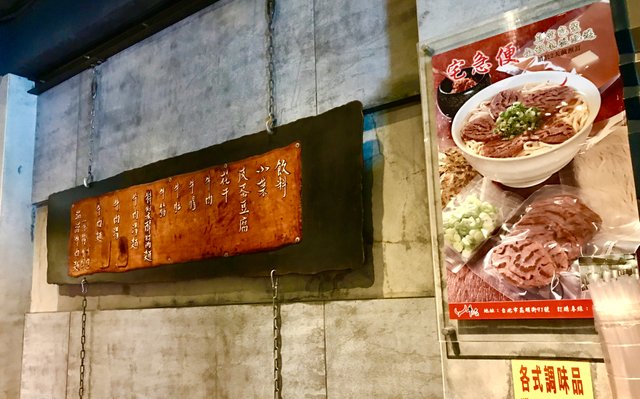
This another board hung on the opposite wall. The bricks and mortar give the restaurant a sense of an unfinished industrial refurbishment. Of course, this was the intention of the design, and I think it bodes well with the overall atmosphere of the restaurant, fitting in with the rustic Japanese colonial style buildings of the area.
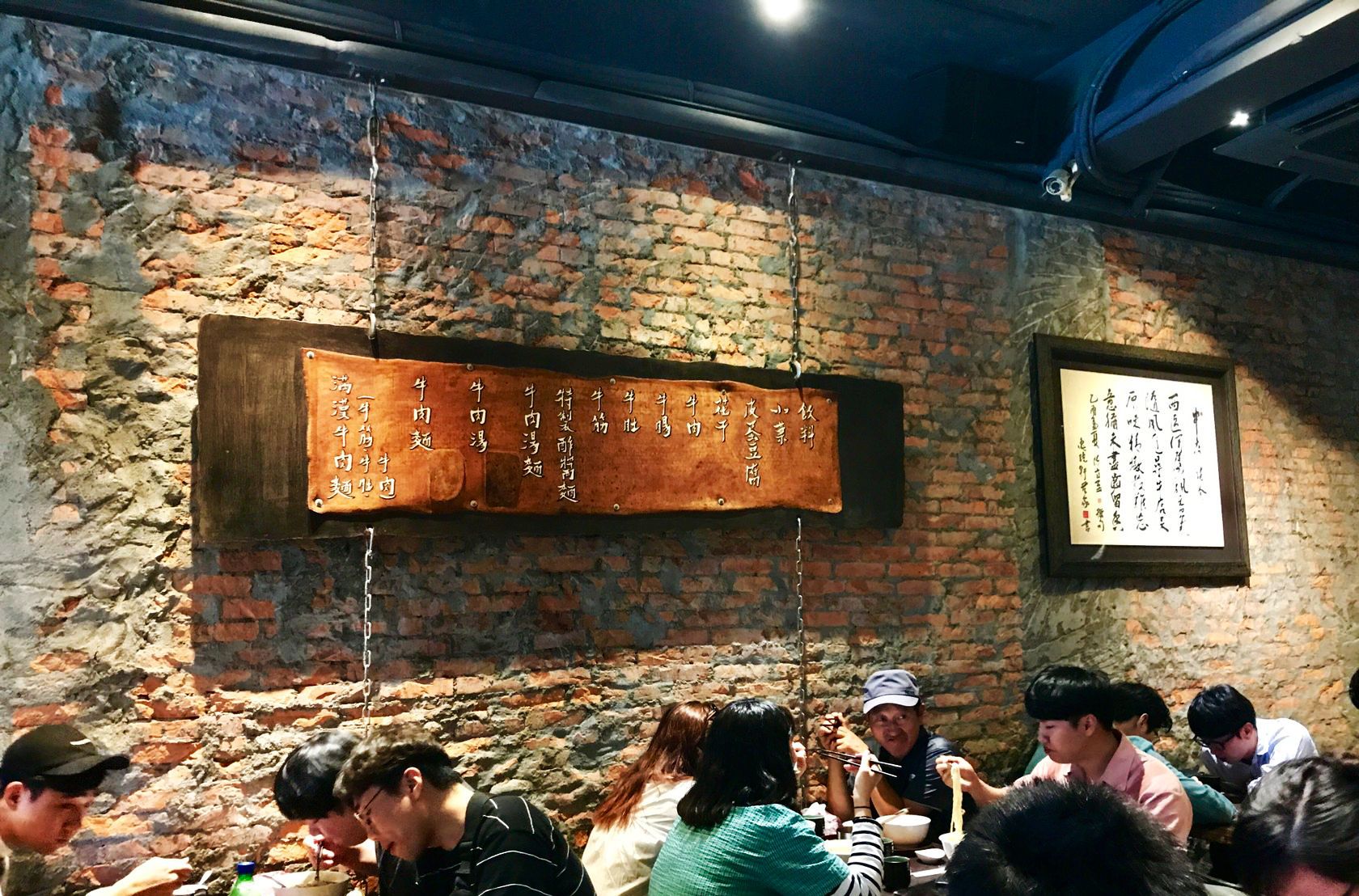
The restaurant has had a significant amount of media attention because of it's prestigious award, and as a result has framed these pieces in a glass display for all to see.
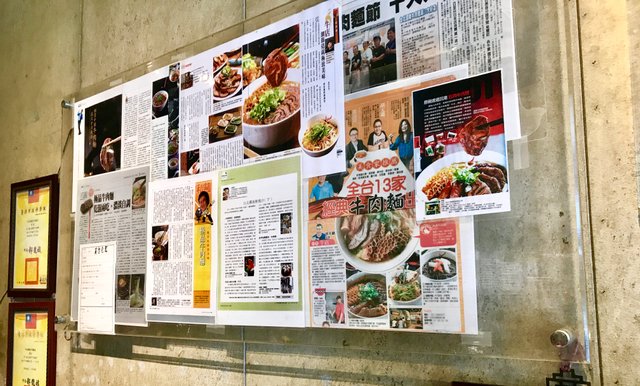
This is the dining floor. Not much space as you can see, and all tables occupied as expected. Right at the back, a formidable painting of a bull, pointing it's horns towards a set of real bull's horns. I always wondered why restaurants like to animate the animals from which their meat comes from. It's a little off putting and doesn't make the meat more appealing, quite the opposite.
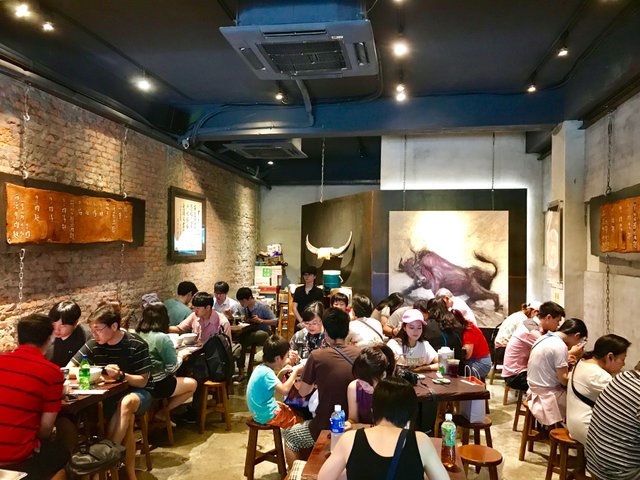
Alas, the Beef Noodle Soup arrives. Let's see what all the fuss is about?
Beef Noodle Soup originated from Mainland China during the Tang Dynasty and was first prepared by the Muslim ethnic minority called Hui. Today's red braised beef noodle soup as popularised in Taiwan, came across from Chengdu, China. It wasn't until it became a popular dish in Kaohsiung that the rest of Taiwan began taking notice and also started cooking this dish.
Up first, the Red Braised Beef Noodle Soup - "Highest Quality".
Beef in the noodle soup tends to lose it's flavour the longer it is left in it's soup as the soup dilutes the taste. On the other hand, beef tends to absorb more flavour the longer it is left in it's sauce. It is this restaurants desire to allow it's guests to choose how much taste is retained in the beef and noodles.
The little piece of paper suggests that you take a sip of the noodle soup for reference, then take some noodles and put it in the small empty bowl. Then, according to the degree of taste of the soup, you can add the beef to the noodles in the small ball, and garnish with the picked vegetables. If the taste is too strong, then add some more soup to dilute. If the taste is too bland, you can add more braised sauce to the mix.
To most Chinese people, Taiwanese cuisine is known for being light. Not only is it not very salty, it's also not very oily. So, my preference was to add more beef sauce to the mix!
I really enjoyed the ability to eat the beef with noodles dry. One of the things that stand out to me was how soft the meat was. You could "chew" it with your tongue!
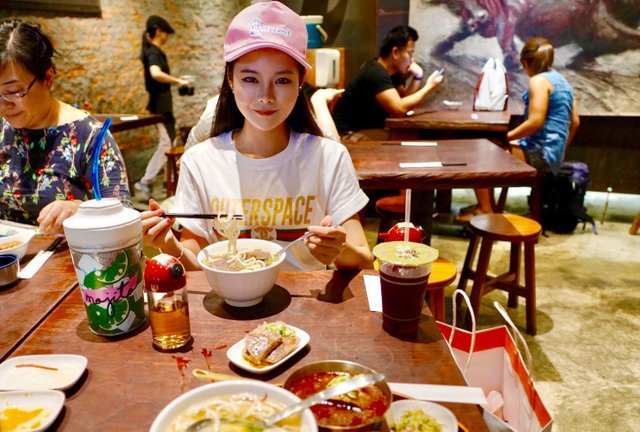
This is the half tendon half meat, beef noodle soup. This is the classic dish that most people will be familiar with. There is an option for full meat instead of half tendon. I would say go for the latter. It's probably the tastiest part of the meat, and also good for people who need some collagen supplementation.
The scallion doesn't just add to the visual appeal of the dish, it also brings out a rich herbal scent that makes the soup taste more flavoursome.
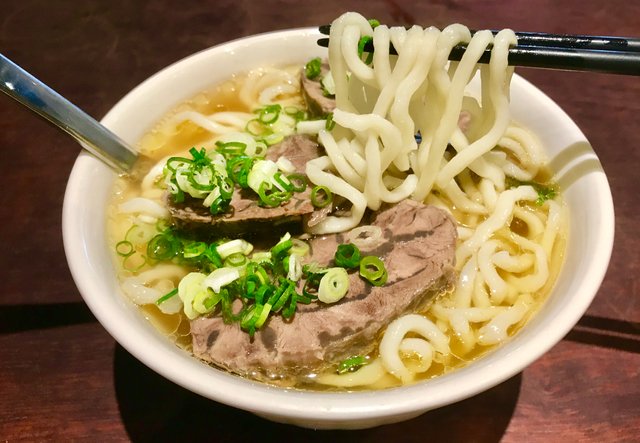
After the noodle soup, I was craving for some dessert, unfortunately these specialised restaurants don't serve desserts.
So I wandered around for about 30 seconds and came across this bubble tea stall. Instead of opting for bubble tea, I was curious about the colourful fruit teas. Some are a mix of quite contrasting colours, others just a single colour.
I opted for a mixed fruit tea, which I thought would be a gradient of colours. Turns out it's just pink. Still, it was worthy of a refreshment and there's always a big variety to choose from, you could never get bored of choice!
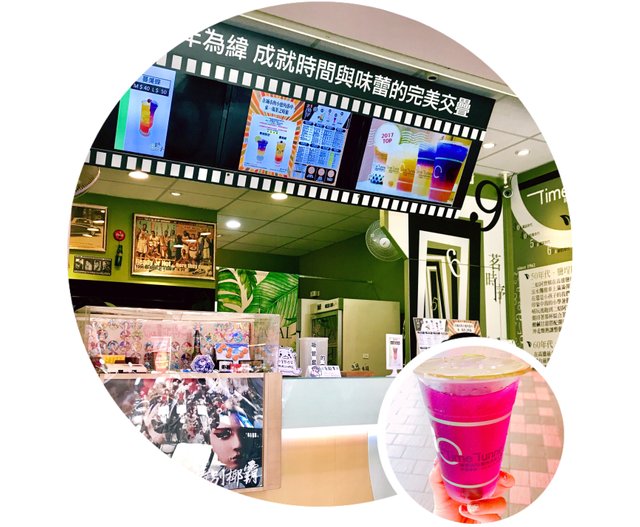
Finally, another short wander from the bubble tea place, and we're at the main entrance to the Ximen MRT station.
Here, the lights are very bright, and there are so many stalls everywhere.

One stall that caught my eye was this Starfruit ice stall. Also originally from Chengdu, this store was founded in 1966 and thus has over 50 years of history. Interestingly, the store has maintained it's original appearance and even selling it's original Starfruit ice, Plum ice and Pineapple ice.
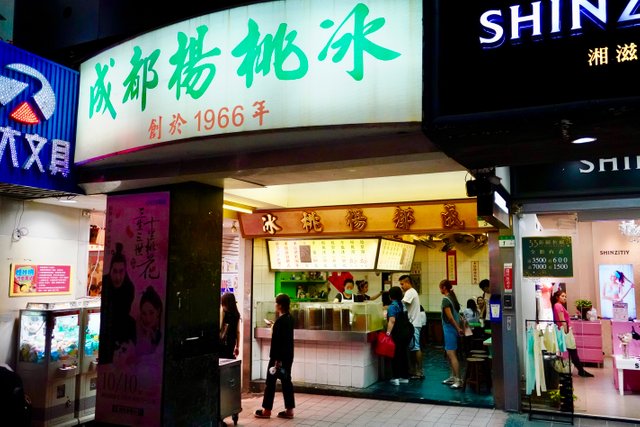
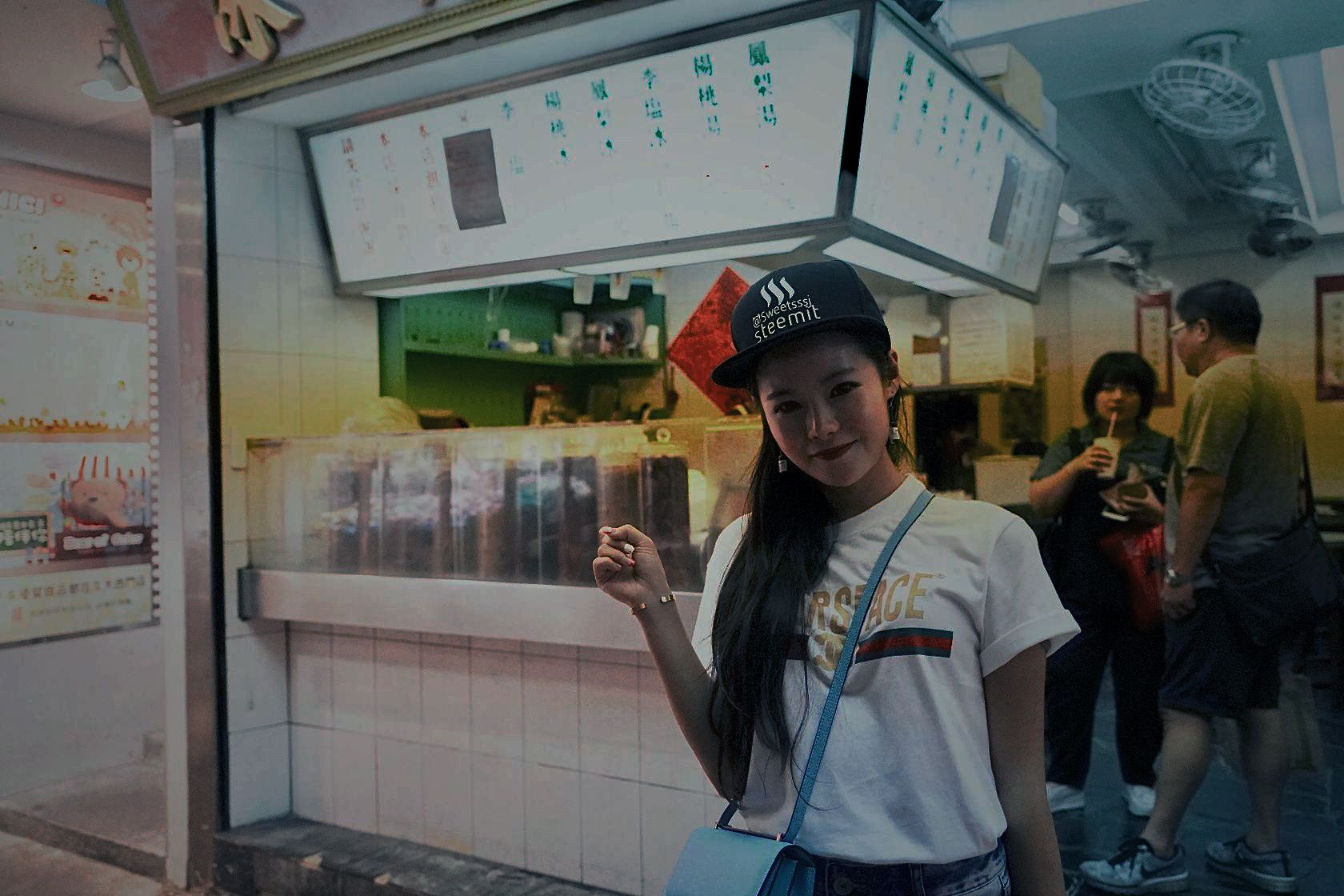
Starfruit takes 3 full months to brew before being ready to serve. It's known for it's particularly sour taste. It's quite different from the sugar filled desserts and drinks we're used to in the modern day, and it certainly gave me a strong kick when I took my first sip. It has a cheeky fragrance with a bit of spice. Despite the odd taste, it was definitely authentic and most importantly natural. Really great for granting some relief after a long hot day.
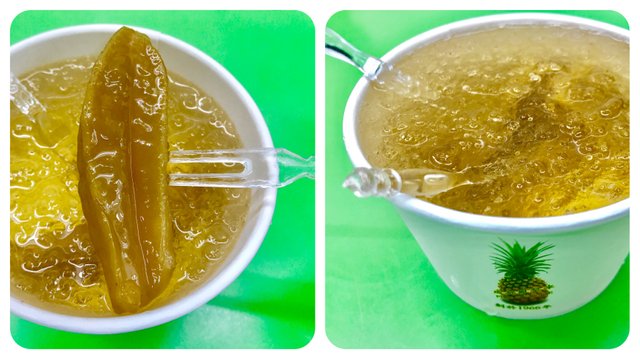
This is my closing picture of the Ximen pedestrian area. One of the oldest places in Taipei, and yet one of most visited. In a later blog, we'll take another look at Ximen more closely, and discover the reasons why it remains one of the most popular places to visit in Taipei.

Today, we learned about the origins of one of the most popular local dishes in Taiwan, the Beef Noodle Soup. Not only did we find out about it's acclaimed history, we also had the chance to visit one of the absolute best restaurants in Taipei to enjoy this dish. It turns out that the preparation has indeed evolved some what over time, and now people are discovering many new ways to prepare, cook and eat this traditional food.
For people who have had Beef noodle soup elsewhere, you will be surprised by the stark contrast of taste the Taiwanese version will bring you, and for that reason, I highly recommend this dish as one of the must haves during your (potential) stay in Taiwan.
Remember to upvote if you liked the post, follow me for more food and travel logs, and leave a comment to let me know what you think!

都说美食让人吃出幸福的味道, 来到台湾之后,每天都是狂喜的状态,好像可以完全忘记不开心是什么滋味了。台湾,除了浓烈的人情味给我别样的亲切感受,那惊艳的美食小吃更是让人赞叹不已。有时候总在想,宝岛台湾应该是用美食征服全宇宙的吧,那千千万万种口味各异的本土小吃,总有一款会夺走你的心,成为你的挚爱。台湾有着多元的民族和文化,历经南岛民族,荷兰人,西班牙人,明朝和清朝,还有日本人,东南亚及战后中国各省人大规模的迁徙移民,再加上宝岛的物产丰富,较早富裕起来的经济可以让台湾从世界各地引进美食。在历史的传承,不断的融合创新中,成功的赋予台湾丰富的饮食文化,从而诞生了各式各样的台湾美食。
今天就让我们一起走进台北最热闹的西门町,探索一下那里的特色小吃。论西门町美食小吃的密集度,绝对是别的街区难以比拟的,住在西门町的我,出门就有大堆极具诱惑力的美食等着我,简直让我欣喜若狂。听到台湾的红烧牛肉面,你会不会已经垂涎三尺了。在我住的旁边就有一家卖牛肉面很牛的店,名叫牛店。它号称可以提供五星级牛肉面,曾经在2010年获得台北国际牛肉面节10大好店的殊荣。我来来回回观察这家店很久,发现人气火爆一点不假,到了用餐时间,门口排队等位的人潮络绎不绝。今天行程不满,我也决定加入排队人潮,试吃一下这碗超人气的牛肉面。这家店由于人手忙不过来,采取自助排队方式,在门口的纸条上写上名字和人数就算排上队了。我在门口足足站了半小时,还好透过橱窗,可以欣赏到厨师们现场制作牛肉面的过程,只见厨师把那色泽鲜亮的美味面条从浓郁的汤锅里捞出来,顿时烟雾缭绕,仿佛隔着玻璃也能闻到那勾魂的香味。
快排到我的时候,店员递给我菜单让我选择,这家餐厅提供丰富的清凉冷菜以应对炎热天气的需求,面条的选择则简单明了。走进餐厅,店內空间不大,位置不多,分为小菜区,煮面吧台,用餐区和自助茶水区,每个部分都干净整齐,布置精细。从细节之处的观察就能发现,虽然店面大小被局限,但是店主在装修上有精致入微的发挥。例如店面灯光气氛柔和,以灰色为主调的环境,水泥地面,复古的红色砖墙,还有店面正中挂着超大幅一头壮牛的海报和那引人注目的牛角,侧面墙上挂着木质画板,上面是手写风格的菜单,乍一看还以为是一幅漂亮的书法画作。餐桌也是由古色古香的原木打造的,把店内的各式装饰融合起来看,确实别有一番风味。
热腾腾香喷喷的牛肉面上桌,这盘极品红烧牛肉面以套餐盘的形式来到桌上,秀色可餐。盘子里纸条上还贴心的提示了面的吃法,首先要尝一口原味汤头,再把2或3勺汤匙的红烧浓汁加入面里,夹些面条到小碗里,拌上红烧汤头,再添加些酸菜拌匀,搭配红烧浓汁里的鲜嫩肉块,就可以尽情享用了。虽然第一次用这样的方式吃面,但是尝过之后才发现,这真是红烧牛肉面最极致的吃法。如果喜欢口味重,还可以加点店里特调的辣酱。我吃的津津有味,完全停不下来,真是让人满足的一餐享受。吃完了够味带劲的牛肉面,我又继续沿着街走,尝了路边百喝不厌的水果茶,凉爽清新的感觉扑面而来,让人欢喜的不得了。
吃过美食之后,我还想找一家甜品吃一吃。这家成都杨桃冰吸引了我的注意,这家店创立于1966年,已经有40多年的历史了。有趣的是,这么多年这家店一直保持着最初的模样,连卖的甜品也只有杨桃冰,李梅冰和凤梨冰。为了保持食物的品质,让杨桃和酸梅入味,这些人工采摘的优质食材需要酿制3个月才能卖。老板递给我菠萝图案的小碗,晶莹剔透的杨桃藏在碎冰下面,尝了一口,才发现这纯天然的新鲜滋味是真的,尝不出一点人工色素和香料的影子,口里只有杨桃纯粹的沁凉滋味,齿颊留香,妙不可言。在炎热干渴的温度里,一碗透心凉的杨桃冰纾解了我一整天的乏累和疲劳。夜幕下的西门町散发着迷人的魅力,今天的台湾美食之旅就要告于段落了,希望大家享受这里的美味佳肴,之后还有更多的美食故事想要和大家分享。
Wow such a great post..... and beef is my favourite
thank sir this post is very nice
i would eat everything here ;)
after several miss delicious's glad to have you back!!
Mount Krakatau, Indonesia
nice
simply amazing!
amazing indeed
看着照片里你一个人吃饭,真想上去陪你吃啊,哈哈。
I would like to sit besides you when you were eating along (looking at the picture of this post). :)
Yeah me too
That is a little creepy... especially the alone part lol
哈哈,下次一起来^^
大家一起再來~~ :D
好主意呢^^
愛你的評論
wanna check my blog out too? Interesting stuff is cooking I swear.
https://steemit.com/life/@dexter-on-cocain/from-a-highschool-dropout-to-hip-hop-sensation-know-the-backstory-of-drake
If I want it not on the side but in front of it, while enjoying a delicious meal, I can feel the lovely gaze @sweetsssj and feel the charm ...
haha I do like company when eating:)
不如对镜吃饭。
follow me please. i already follow u.
It all looks so delicious!
tastes delicious too! :)
I love all of the colors in the market. The streets look so clean too! Great post.
an interesting post today, sssj, a departure from the elegant hotels and fine dining establishments you usually frequent.
Frankly, I find fine dining at times to be snobbish, but I've noticed you gravitate toward establishments that are 'real' and offer excellent food, often homemade.
The emphasis on beef at the Cow Inn reminds me of peoples' preference for tasty, fast food.
McDonald's is a world-wide purveyor of this concept and they are even planning to open a restaurant a day in mainland China. The Steer Rules!
Getting back to the post, it seems your theme today is comfort food, and what's more comforting than delicious soup and steaming hot tea?
Admittedly, street food has its downside particularly with regard to ambiance, but on the other hand, sipping hot soup beneath an awning on a rainy day creates a cozy atmosphere of its own.
A delightful change of pace from your usual posts, @sweetsssj
john, thank you for the quick reply and noted insight.
I've written a little about the Chinese attitude towards fine dining, amongst other activities considered superficial. But, it's very much endowed in the Chinese psyche because of it's lagging development relative to the west. Take afternoon tea for example, the British have had this for hundreds of years and no longer consider this activity a big deal. The Chinese on the other hand only discovered this in recent years. To them, it means more than just having tea, it is a symbol of status. Countries that developed into wealthier economies in recent years and in short spaces of time, all exhibit this typical behaviour. The Asian Dragons - Singapore, Taiwan, South Korea, Hong Kong. And now China.
As time passes, the rest of society catches up, and flamboyant displays of decadence no longer become central to attracting the attention of peers. People start going back to basics, as you said enjoying things like McDonalds which is becoming as popular as 7 Eleven is in Taiwan.
In the words of Rick Warren, people stop spending money they don't have, on things they don't want, to impress people they don't like.
Whilst I do enjoy fine dining, I certainly never turn away from establishments like the Cow Inn, and if i'm honest, I've never rated Michelin restaurants higher than these restaurants in terms of quality of food, I would be a very biased and selective connoisseur if I did!
I stand by tasting food from all walks of life, whether it's a fried pancake from a night market stall on the corner of the street, or foie gras and caviar from The Dorchester in Mayfair. To be honest, i'd probably choose nightmarket food any day of the week! :)
I appreciate that about you, sssj - you are all about the food and not the display.
You are an amazing person. Your reading and experience travelling has broadened your taste and provided you with insight into more than merely matters culinary.
A quite from Rick Warren? You certainly do live a purpose-driven life :)
Thank you for the insight into the changing Chinese attitude toward the rituals surrounding the afternoon tea - very interesting, and appropriate especially considering the long tradition of tea in China.
By the way, I would like to see a post sometime in the near future about cats. Yes, I have a cat, or rather he has me, but I'm not given over to ailurophilia rampant on Youtube. My tabby is my Muse, but lately, I've only caught glimpses of your feline companions.
Just a small request :)
The problem with the Michelin rating system is that people's tastes are influenced heavily by what they eat growing up, and therefore, what food is considered better or worse tasting depends on culture. Michelin is super biased towards french restaurants, which isn't necessarily a bad thing - Michelin is just a french tire company which originally made the guide as a way to market themselves towards french motorists, and of course they would target their customers. It's only a problem when they try to make it more general than that, and say that the guide is some official measure of objective tastiness when it really isn't.
I think crowdsourced rating systems like yelp or google maps are better at identifying tasty food rather instead of "fancy" food, but you could also say that its just targeting millenials/people who like smartphones. In something as subjective as food there is no such thing as a rating system without bias, it's just a matter of finding experts / systems that have similar tastes to you personally.
https://steemit.com/steemit/@zobi45/nokia-7-with-bothie-camera-mode-snapdragon-630-soc-launched-in-china-price-specifications
Siempre me ha llamado la atención su gastronomía, la mezcla de sabores, productos y sobre todo hortalizas frutas verduras legumbres, todo en un platillo que hace una explosión de sabores
All that food make me gain some weight hehe...that's a cool restaurant you visiting :))
haha i wish i was in your shoes.. I want to gain weight!
Starfruit brew doesn't look very appealing.. but maybe it's healthy?
Yes, but at the same time, it's an acquired taste. Sour is a strange sensation, one which improves the more you get used to it. Still, you're probably right, health is the main reason people drink it!
I love star fruit, it is one of my favorites here in Trinidad and Tobago. We in the Caribbean have a wide variety of food, from Indian to Syrian, to African, to Chinese even American. All in a very little Island. @sweetsssj you should come visit us sometime.
john, i've really wanted to visit for quite a while, maybe in my next visit to that part of the world :)